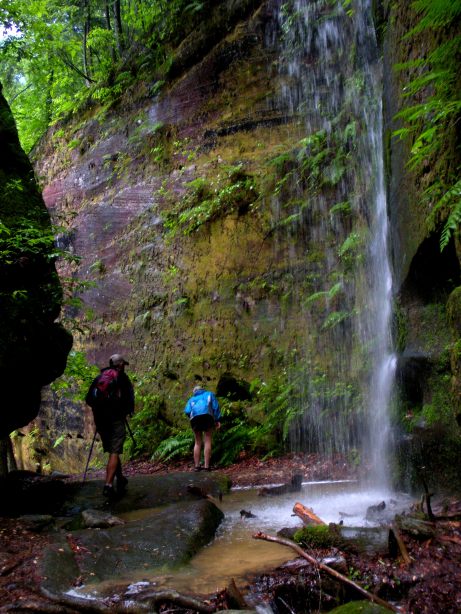
(This is a monthly installment of an educational web series aimed at translating peer-reviewed science into regional case studies of ecology and evolution in Appalachia. For more information, see the intro page to the series here.)
Sometime around 1940, entomologist B.B. Fulton was in the midst of spending a long summer at his cabin in the mountainous western section of North Carolina. One hot evening, Fulton picked his way down a steep embankment to a nearby springhead behind the cabin to gather water. Stumbling in the dark, Fulton noticed something odd. The entire streambank was glowing with pinpoints of bright blue light.
The source of the strange blue glow – as Fulton would later discover – was the fungus gnat (Orfelia fultoni), a small insect almost invisible to the naked eye. Fungus gnats are fairly unremarkable as adults, appearing as a small flying insect not much bigger than a fruit fly. As larvae, however, fungus gnats have the unique ability of emitting what scientists have come to discover as the world’s brightest blue hue given off by an organism.
The fungus gnat’s incredible light show results from a “cocktail” of special proteins concentrated inside both ends of the larvae. The proteins, like all other proteins inside living organisms like ourselves, are coded for by a series of genes nested within the fungus gnat’s larger genome. (To better understand the coding of proteins by DNA, think about the source code that is currently guiding the appearance and organization of the website you are now viewing.) When the proteins in this “cocktail” mix together, they produce the fungus gnat’s characteristic blue glow – not all that unlike the chemical reaction that occurs inside a glowstick when you initially “snap” it to activate its light.
While scientists are still unsure of precisely how this ability arose, the gnat’s special proteins likely came about as the result of small mutations in its genetic code that resulted in different proteins being assembled than normal – a process that occurs even inside our own bodies regularly, and usually not to any significant consequence. In the fungus gnat’s case, however, the change allowed for the gnat larvae to attract prey in ways that increased its ability to obtain food. Biologists have interestingly found that the gnat’s light show serves as a “lure” for other insect species. The gnat larvae’s prey are specifically attracted to the light, move toward it, and become trapped in a small web-like structure built by the larvae, where they become a meal. (For some amazing photos of the larvae at work, go here.)
Since their original discovery and formal scientific naming by Fulton in 1941, the fungus gnat has been documented from many sites across the southern Appalachians. Some of the most well-known sites include the western North Carolina mountains (near the site of Fulton’s initial discovery), as well as Tennessee’s Hazard Cave and northwest Alabama’s Dismal’s Canyon. One of the only other glow-worms known on the planet lives in cave systems within New Zealand – a whole world away from the streambanks and bluffs of the southern mountains. Even this New Zealand species, though, has been found to have an entirely different mechanism for creating its glow than O. fultoni.

Why does the fungus gnat’s glow matter to evolutionary biology? The reason lies in the benefit that the larvae’s lure provides to the organisms. Biologists have shown using experiments in Highlands, North Carolina that the brightly-glowing lures are significantly more effective at attracting prey in O. fultoni than in larvae with their lures rendered invisible. These results (among others from the scientific literature) suggest that the fungus gnat’s glow is a wonderful example of an evolutionary adaptation at work. By giving a benefit to the gnat larvae in the form of an improved method for catching prey, fungus gnat luminescence likely persists in the species not as a one-time genetic fluke but as a valuable trait passed through generations via natural selection. This process – the increase in frequency of an inherited trait over generations due to a benefit to the organism – is a fundamental component of evolutionary biology and, in the fungus gnat’s case, provides a beautiful example of an adaptation that almost went undiscovered….if it hadn’t been for a thirsty biologist stumbling around in the dark.
The next installment of the series will examine some of the larger consequences of natural selection in another native organism in the southern Appalachians.
_____________________________________________________________________
Places to view fungus gnats in the Appalachians: (view on a map)
- Dismal’s Canyon (privately-owned preserve in northwest Alabama)
- Pickett State Park, Tennessee
- Highlands, North Carolina (general area)
______________________________________________________________________

You must be logged in to post a comment.